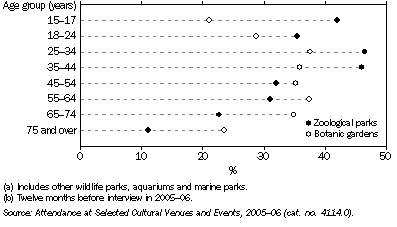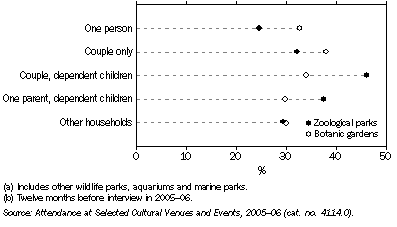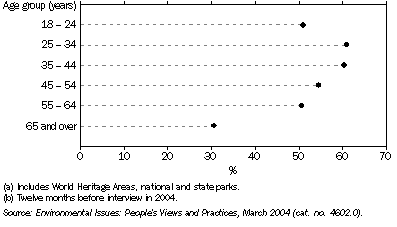ATTENDANCE
Zoological parks and Botanic gardens
Zoological parks and aquariums are primarily engaged in the breeding, preservation, study and display of native and/or exotic fauna in captivity and are accessible to the general public. Similarly, botanic gardens have been established to collect, study, exchange and display plants for research and for the education and enjoyment of the public.
The 2005-06 survey of Attendance at Selected Cultural Venues and Events found that almost 5.4 million Australians aged 15 years and over visited a botanic garden and around 5.7 million visited a zoological park in the twelve months prior to being interviewed.
Residents of Western Australia had the highest attendance rates for zoological parks (43%) while Australian Capital Territory residents recorded the highest attendance rates for botanic gardens (44%).
9.1 ATTENDANCE AT ZOOLOGICAL PARKS AND BOTANIC GARDENS(a), By state and territory - 2005-06(b) |
|
 | ZOOLOGICAL PARKS(a) | BOTANIC GARDENS |
 | Number | Attendance
rate | Number | Attendance
rate |
 | '000 | % | '000 | % |
|
| New South Wales | 1 780.0 | 33.2 | 1 517.7 | 28.3 |
| Victoria | 1 489.5 | 37.0 | 1 479.9 | 36.7 |
| Queensland | 1 023.4 | 33.2 | 1 146.7 | 37.2 |
| South Australia | 463.7 | 37.9 | 446.8 | 36.5 |
| Western Australia | 677.6 | 43.4 | 520.8 | 33.4 |
| Tasmania | 120.9 | 31.6 | 123.4 | 32.3 |
| Northern Territory | 39.9 | 36.0 | 43.1 | 38.8 |
| Australian Capital Territory | 104.8 | 41.4 | 112.4 | 44.4 |
| Australia | 5 699.8 | 35.6 | 5 390.9 | 33.7 |
|
| (a) Includes other wildlife parks, aquariums and marine parks. |
| (b) Twelve months before interview in 2005-06. |
| Source: Attendance at Selected Cultural Venues and Events, 2005-06 (cat. no. 4114.0). |
For zoological parks, those aged 25-44 years were more likely to attend than any other age group. The presence of children in the household was also an important factor for attendance at zoological parks, although it seemed to have little bearing on rates of attendance at botanic gardens.
9.2 ATTENDANCE AT ZOOLOGICAL PARKS AND BOTANIC GARDENS(a), By age
- 2005-06(b)

9.3 ATTENDANCE AT ZOOLOGICAL PARKS AND BOTANIC GARDENS(a), By household type
- 2005-06(b)

Nature parks and reserves
Nature parks and reserves include Australia's national parks and other protected areas of land or sea especially dedicated to the protection of biodiversity and other natural and cultural resources.
Australia has 18 World Heritage Areas and over 1,400 national and state parks and reserves which are managed by the Australian Government and each of the state/territory governments. The area covered extends beyond Australia's coastline to include marine protected areas up to three nautical miles out to sea as well as national parks on the Cocos (Keeling), Christmas and Norfolk Islands.
More than 7.8 million Australians (52%) aged 18 years and over visited a World Heritage Area, national or state park in the twelve months prior to March 2004, according to
Environmental Issues: People's Views and Practices, 2004 (cat. no. 4602.0). Residents of the Northern Territory recorded the highest attendance rate (61%) and South Australians the lowest (49%).
9.4 ATTENDANCE AT NATURE PARKS(a), By state and territory - 2004(b) |
|
 | Number | Attendance rate |
 | '000 | % |
|
| New South Wales | 2 498.0 | 49.6 |
| Victoria | 1 937.8 | 51.0 |
| Queensland | 1 538.3 | 53.9 |
| South Australia | 565.0 | 48.8 |
| Western Australia | 893.9 | 60.3 |
| Tasmania | 201.3 | 56.4 |
| Northern Territory | 63.5 | 60.9 |
| Australian Capital Territory | 135.2 | 57.2 |
| Australia | 7 832.9 | 52.1 |
|
| (a) Includes world heritage parks and state parks. |
| (b) Twelve months before interview in 2004. |
| Source: Environmental Issues: People's Views and Practices, March 2004 (cat. no. 4602.0). |
The survey found that Australians aged 25-44 years and couple households with dependent children were the most likely to visit a World Heritage Area, national or state park.
9.5 ATTENDANCE AT NATURE PARKS(a), By age
- 2004(b)

9.6 ATTENDANCE AT NATURE PARKS(a), By household type
- 2004(b)

 Print Page
Print Page
 Print All
Print All